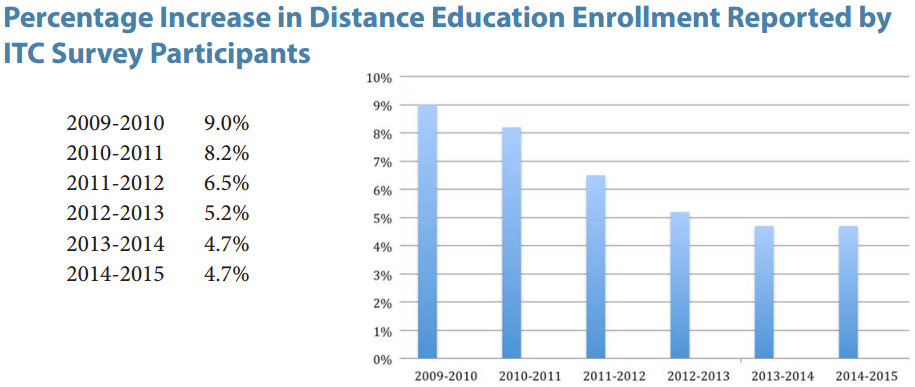You have /5 articles left.
Sign up for a free account or log in.

Instructional Technology Council
Online courses have for years driven enrollment growth at community colleges, but as more students take their chances in the job market, institutions face new challenges to retain them, a new study found.
During the height of the recent recession, community colleges saw double-digit percentage growth in their online courses, according to the Instructional Technology Council, which is affiliated with the American Association of Community Colleges. But the ITC’s most recent survey of trends in online education at two-year colleges shows growth last academic year sat at 4.7 percent -- the lowest in about a decade.
The report is being published this week to coincide with the AACC’s annual convention in Chicago. The ITC received survey responses from online education directors at 100 of its member institutions.
Fred Lokken, a member of the ITC’s board of directors, wrote in the report that the enrollment trends reflect a “typical reality” for community colleges. “As the economy improves, students begin to stop out to take advantage of their ability to get a job,” he wrote.
The good news for community colleges is that the rate of growth in online enrollments is plateauing. After half a decade of decline, growth last academic year was statistically equivalent to the year before. Stability isn’t enough, however. Even though their online programs are growing by about 5 percent, survey respondents said their total student enrollment declined by 2.73 percent on average last year.
Since the survey does not report raw numbers, the decline may be less severe than it appears, said Cali Morrison, communications manager at the WICHE Cooperative for Educational Technologies (WCET). WCET has tracked and dissected online education enrollment numbers since the federal government began reporting them in 2014.
The online enrollment growth may have been cut in half, Morrison said in an interview, but thanks to years of solid growth, community colleges appear to still be adding a healthy number of new online students. “It may not be so grim,” she said.
Moreover, Morrison added, community colleges are in a better position today than they were before the recession when it comes to retaining students who may have enrolled in anticipation of an improving economy. With online courses and degrees, community colleges can make the case that students will be able to balance their education, work and personal obligations, she said.
“I see that as an opportunity for colleges,” said Morrison, adding that two-year colleges should clearly communicate to students how they can continue their studies while not physically present on campus.
Community colleges have embraced online education to a much greater extent than four-year institutions have. Virtually all of the administrators surveyed by ITC (94 percent) said online courses are equivalent or superior to face-to-face courses (faculty members were not surveyed).
Administrators at four-year institutions generally hold a more positive opinion than faculty members on online courses, but some still remain skeptical. Inside Higher Ed’s latest survey of attitudes on technology, for example, found that 64 percent of technology administrators believe online courses are at least as good as face-to-face courses.
The community college sector is also showing remarkable uptake of fully online degree programs. In 2010, 66 percent of respondents said their institution offers at least one online degree. Now, virtually all do -- 92 percent of them. The number of community colleges offering online certificate programs is also on the rise, increasing to 84 percent of respondents from 76 percent last year.
“From the inception of online learning, the community college movement embraced the value of online education to the fullest,” Lokken wrote. “Community colleges recognized the intrinsic value of this mode of instruction -- greatly improved access to higher education.”
As online programs become even more commonplace at community colleges, institutions are changing their administrative structures. This year, 75 percent of survey respondents said they report not to someone in the campus IT office but to an academic administrator -- including vice presidents, deans, provosts and chancellors.
“To me, that’s giving greater weight to distance education as an academic track,” Morrison said. “It’s become a core part of the institution.”









